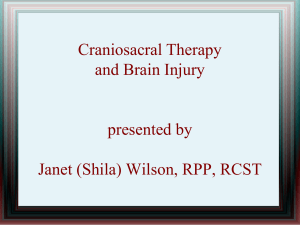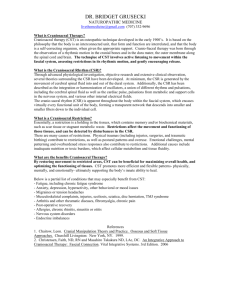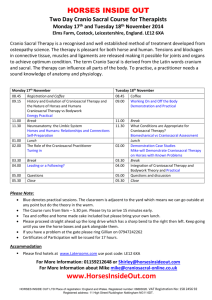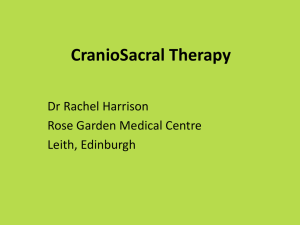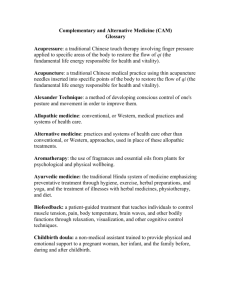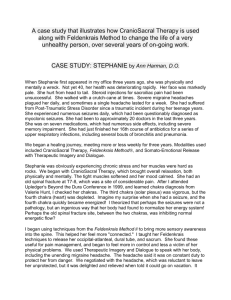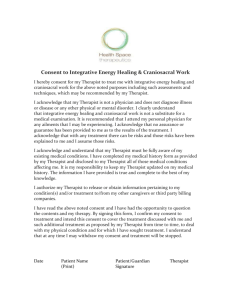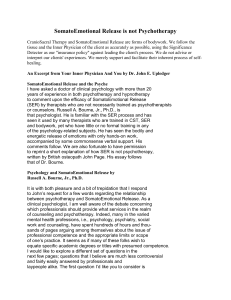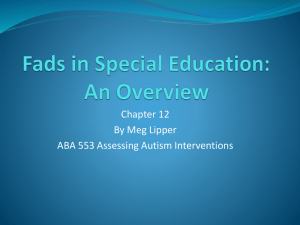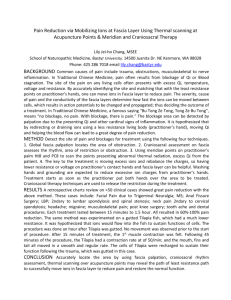Common Questions regarding CranioSacral Therapy
advertisement
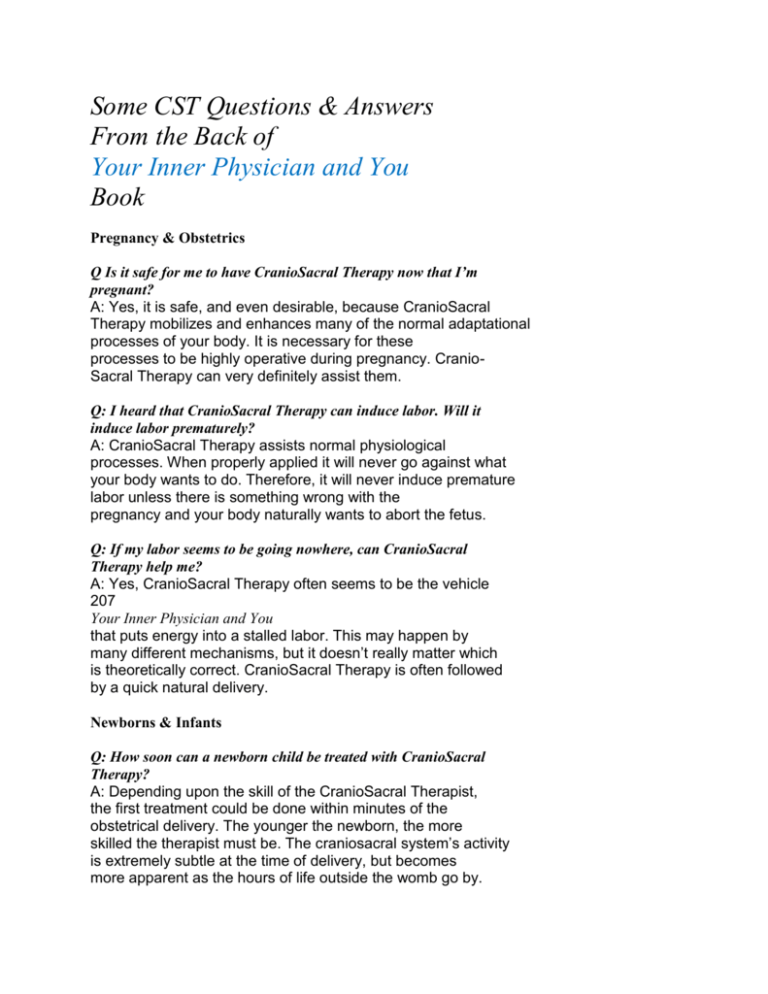
Some CST Questions & Answers From the Back of Your Inner Physician and You Book Pregnancy & Obstetrics Q Is it safe for me to have CranioSacral Therapy now that I’m pregnant? A: Yes, it is safe, and even desirable, because CranioSacral Therapy mobilizes and enhances many of the normal adaptational processes of your body. It is necessary for these processes to be highly operative during pregnancy. CranioSacral Therapy can very definitely assist them. Q: I heard that CranioSacral Therapy can induce labor. Will it induce labor prematurely? A: CranioSacral Therapy assists normal physiological processes. When properly applied it will never go against what your body wants to do. Therefore, it will never induce premature labor unless there is something wrong with the pregnancy and your body naturally wants to abort the fetus. Q: If my labor seems to be going nowhere, can CranioSacral Therapy help me? A: Yes, CranioSacral Therapy often seems to be the vehicle 207 Your Inner Physician and You that puts energy into a stalled labor. This may happen by many different mechanisms, but it doesn’t really matter which is theoretically correct. CranioSacral Therapy is often followed by a quick natural delivery. Newborns & Infants Q: How soon can a newborn child be treated with CranioSacral Therapy? A: Depending upon the skill of the CranioSacral Therapist, the first treatment could be done within minutes of the obstetrical delivery. The younger the newborn, the more skilled the therapist must be. The craniosacral system’s activity is extremely subtle at the time of delivery, but becomes more apparent as the hours of life outside the womb go by. In order to be sure of what he/she is doing, the CranioSacral Therapist should be able to perceive the craniosacral rhythm of the newborn. So for one therapist, one hour after delivery may be the right time to treat the child. Another therapist with less experience and perceptual development may need to wait a day, a week, a month or a year. Q: Why would I want my newborn child treated? A: CranioSacral Therapy can correct problems in the craniosacral system immediately and permanently. These problems, when corrected, may avoid the development of colic, respiratory problems, hyperactivity, dyslexia, seizure disorders, floppy baby syndrome and allergies. Although not proven as yet, I believe it can also thwart many cases of cerebral palsy, scoliosis, and dental problems that require orthodontia later in life. Furthermore, it has been shown that the child’s general health is improved. Postpartum Mothers Q: How can CranioSacral Therapy help the new mother? A: In several ways: (1) It helps restore hormone balance; (2) It helps alleviate postpartum depression; and (3) It restores normal pelvic function, thus eliminating many post-delivery back problems and the like. Q: I had problems with high blood pressure after my second delivery. Could CranioSacral Therapy help this? A: Very often high blood pressure for any reason returns to normal after just a few CranioSacral Therapy sessions. Q: How about helping me lose the weight gained during pregnancy? A: If normalizing your endocrine system and mobilizing your bodily fluids would help you lose weight, the answer is yes. Children Q: What kinds of problems with children does CranioSacral Therapy help? A: This is a tremendously broad question. I’ll try to answer it based only on my own personal experience. 1. Allergies Respiratory—CranioSacral Therapy is very definitely helpful when combined with SomatoEmotional Release. Food—CranioSacral Therapy is also helpful when structural problems of the skull are found and released. There are other reasons for food allergies that are not necessarily affected by CranioSacral Therapy. 2. Colic, digestive and elimination problems are corrected by 209 Your Inner Physician and You CranioSacral Therapy about 75 percent of the time unless they are due to tumors or other significant pathological problems. 3. Psychological problems—CranioSacral Therapy helps the therapist develop trust and rapport with the child very quickly. In this way the emotional problems can be discovered. On the other hand, I have seen several “psychological” problems disappear when a craniosacral problem was corrected. These problems had no emotional basis. Although they appeared to be psychological, they were due to physiological craniosacral system dysfunction. 4. Hyperactive children are very effectively treated by CranioSacral Therapy when the problem is not emotional in origin. In my experience, about 50 to 60 percent of hyperactive child problems have a basis in the craniosacral system. 5. Learning disabilities and dyslexia—As in the case of hyperactive children, when the problem originates in the craniosacral system, the treatment is very effective. This is about 50 to 60 percent of the time. 6. Down’s syndrome—This is a very difficult question. What I can say is that Down’s syndrome children who have received CranioSacral Therapy have been happy and often exceeded conventional expectations. 7. Mental retardation—Whether or not the “retarded” child will respond dramatically to CranioSacral Therapy depends upon the cause for the “retardation.” I have had some remarkably positive results in selected cases. In others, they got healthier when treated, but didn’t necessarily get smarter. 8. Cerebral palsy—Most of my experience has been with spastic cases. These children have all improved—some very dramatically, some just a little. Once again, it depends on the cause of the palsy. Sometimes the spasticity is relieved but the child is left with flaccid paralysis. Flaccid is more comfortable than spastic, so this is worth something. 9. Seizures—The response of the seizure-disordered child is strictly dependent upon the reason for the seizures. I have seen many children completely stop having seizures with no medication as the CranioSacral Therapy was carried out. Some children whose seizures are due to deeper brain disorders do not respond at all. The majority stop having seizures and require a reduced dosage of medication. 10. Autism—We did three years of intensive research with autistic children in the late 1970s. We saw significant improvement in self-destructive behavior, in the display of affection, and in social interaction. These improvements usually deteriorated within three to six months after CranioSacral Therapy was discontinued. This is an ideal situation for parents to learn to treat their child, and a matter for further research. Q: Does CranioSacral Therapy provide any benefit for the normal child? A: I feel very strongly that CranioSacral Therapy is one of the more powerful and effective health-enhancement treatment programs available today. So in view of my bias, the answer is yes. Q: I heard that CranioSacral Therapy can be used in childhood diseases like measles, mumps, chicken pox, etc. A: My experience has been that CranioSacral Therapy can be used to effectively break the fever and ease the child through the crisis in most of these conditions. I think it bolsters the immune system and mobilizes the autonomic nervous system so that the body’s defenses are better used. Q: What about scoliosis? A: In some cases of scoliosis, the cause is craniosacral. More often than not, though, the tube of dura mater membrane that goes down the spinal canal has a twist/torque in it that can be detected very early in life. The spine resists the torque as long as it can, but sometime in the prepubescent period or in early adolescence, the spine begins to twist in response to the twisted dura mater membrane. This is the beginning of a scoliosis. Sometimes, if caught early, this can be corrected using CranioSacral Therapy, and the scoliosis disappears. Q: How does CranioSacral Therapy work with orthodontia? A: Very well indeed. It often shortens the course of orthodontia and occasionally eliminates the need entirely. I suggest that all children have CranioSacral Therapy before embarking on a course of orthodontic correction. Q: Can you help cross-eyed children? A: When the problem is due to dura mater membrane tension affecting the nerves to the eyes, the results are excellent and dramatic. I have helped several children avoid eye surgery using CranioSacral Therapy techniques. Adults Q: I don’t really have a complaint, but I am curious. Could I get CranioSacral Therapy? A: By all means. We really believe that CranioSacral Therapy on a regular basis, no matter how good you feel, is some of the best health-enhancement activity that you can do. You may discover that you feel even better than you thought you could. I’m sure that you will have fewer sick days. Q: What does CranioSacral Therapy do for headaches? A: Headaches are one of the most common complaints that we treat with CranioSacral Therapy and its offshoots. I would say that we are 80 to 90 percent successful no matter what type of headache is presented to us. Q: How about chronic back pain? A: Once again, the success is outstanding when CranioSacral Therapy is used for back pain, including ruptured discs. We work from the inside (“core”) out. When the “core” is corrected, the outside (peripheral problem) either corrects itself or becomes amenable to conventional treatment. Q: I heard that you offer special intensive programs through your clinic in Florida. What are they and how do they work? A: A number of one- and two-week intensive programs are offered through our UI HealthPlex clinic in Palm Beach Gardens, Florida. Among the conditions addressed are: brain and spinal cord dysfunction, learning disabilities, post-traumatic stress, autism, pain, cancer recovery and therapist rejuvenation. Each program features a specially selected team of clinicians comprised of UI HealthPlex staff and skilled visiting therapists. Drawing on a variety of complementary approaches, including CranioSacral Therapy and SomatoEmotional Release, the clinicians work together in multiple-hands sessions as needed to address the specific health concerns of each individual. These programs offer an exceptional opportunity to receive some of the most innovative healthcare currently available anywhere. For information, you can call the clinic at 561-622-4706. Q: If this treatment method is so good, why isn’t it incorporated into the conventional healthcare system? A: Change takes time. More and more recognition is coming our way, but we are flying in the face of many dogmas, not the least of which are: 1. Skull bones don’t move. 2. Minds can’t control bodies. 3. All memory is in the brain. 4. Transference of energy between patient and therapist is ridiculous. 5. Nervous-tissue injury is permanent. And so on... In view of these antiquated but firmly held beliefs, I think our level of acceptance is remarkably good. Q: What can you do for depression? A: In specific types of depression, CranioSacral Therapy is probably the most effective treatment available. In others, when combined with SomatoEmotional Release and Therapeutic Imagery and Dialogue, the results are good. Q: What can you do for Pre-Menstrual Syndrom? A: In most cases we can move the patient toward total eradication of this problem. CranioSacral Therapy can and does help the pelvic organs to function more efficiently. We also improve the function of the endocrine system—in this case the pituitary, adrenal and ovarian glands. Q: What about chronic fluid retention? Can you help that? A: CranioSacral Therapy enhances fluid mobility throughout the body; therefore it helps fluid retention, whether due to heart problems, kidney problems, mineral imbalance, or any other cause. It must be done regularly if the cause is ongoing. Here we like to teach a family member or loved one to treat the patient on a daily basis. Q: What is your track record with arthritis? A: There are several kinds of arthritis. The most common is osteoarthritis. Probably the most notorious is rheumatoid, which is inflammatory in nature. Both types of arthritis are amenable and responsive to CranioSacral Therapy. In these cases we also like to teach family members to treat the patient daily. This approach gives the best response. Q: I hear you have had some interesting results with coma patients. A: Yes, the number of patients is not high, but of the few I’ve treated the results have ranged from good to spectacular. Some of our more advanced students report similar results. We would welcome the opportunity to do more work in this field. Q: What’s the difference between CranioSacral Therapy, Cranial Osteopathy, Chiropractic Craniopathy and Sacro-Occipital Technique? A: In the other approaches mentioned above, the movement of the bones is the major objective. In CranioSacral Therapy, bones are used to manipulate much more deeply into the system of membranes and fluids. Therefore the bone movement is an enabling objective in CranioSacral Therapy. In all fairness, the other forms of cranial work are beginning to use the concepts of CranioSacral Therapy and are starting to look and work more deeply now. Another major difference is that CranioSacral Therapy uses a much lighter touch. Most often, the patient’s internal forces and energies provide what is required for therapeutic corrections of the craniosacral system. In cranial work, as practiced in both the traditional osteopathic and chiropractic modes, the therapist more often than not forces the “correction” upon the patient. This approach allows for more mistakes by the therapist and for more trauma to result from the treatment sessions. Q: Why do some people feel worse after a treatment? A: There are several reasons for this post-treatment discomfort. One is that their body is re-experiencing a previous trauma or injury as it is releasing from the tissues. This can take a few days. Another is that areas of “numbness” have come back to “life” and are more sensitive. Also, it often happens that the body has adapted to a malfunction. When we remove the adaptation as we get closer to the nucleus of the problem, the suppressed pain comes back to the surface. We must also consider that pain is a perception. When hope of correction of a problem is held out before the patient, the nonconscious makes the pain worse so that we won’t stop before the whole problem is solved. There are many more individual reasons for a worsening of symptoms after a good treatment. We cannot neglect the possibility that the therapist screwed up. This can cause a painful reaction. This screw-up is usually by the application of excessive force and/or trying to make the patient’s body do what the therapist decides is right. We preach the sermon of “follow the body, don’t lead it.” Q: What is tissue or cell memory? A: I don’t know exactly, but if you watch what happens during treatment and healing processes, it looks like individual tissues and probably cells have recall of experiences they have gone through. Q: How can you tell what is wrong with me by picking up my legs? A: We use the perception of very subtle energy activities in the body to focus on the source of abnormal energy patterns. We also very gently traction the legs to see if resistance of tissues is equal or lacks symmetry. We do these kinds of evaluations all over your body; you just notice it more in your legs because picking up the legs is more apparent to you than when we touch your ribs, your shoulders or your head. But we are doing essentially the same kind of evaluation on many body regions. Q: Why does it look like the therapist isn’t moving? A: Because we are just barely moving. What we look for in CranioSacral Therapy is extremely subtle. It takes practice, but once learned you have it forever. Q: How can you get any treatment done using such a light touch? A: As I said earlier, in CranioSacral Therapy we try very hard to get the patient’s body to make the correction. We, the therapists, assist the natural corrective tendency of the patient’s body. When you use more than a little force, you may recruit the patient’s bodily defense against your intrusion. When the patient’s body begins to defend itself against the therapist, the tissues of the patient’s body tighten in an attempt to preserve the status quo. When confronted with this situation, the therapist can: (1) apply more force to overcome patient resistance; or (2) lighten up the touch, as we do in CranioSacral Therapy, thus allowing the patient’s tissues to relax and obtaining a therapeutic release by adding just enough to the patient’s own self-corrective mechanism to be effective. Once again we are confronted with that difference in approach which separates CranioSacral Therapy from other cranial techniques. This difference is what makes CranioSacral Therapy so safe and so useable by non-physicians. It can be applied cookbook style and still obtain an excellent therapeutic result. Q: I’ve had CranioSacral Therapy, and I was astonished by the approach. My pain was in my shoulder, and it was cured by the therapist working with my sacrum and pelvis. How can this happen? A: There are several possible ways this could happen. First, the craniosacral system connects the sacrum and pelvis to the neck and head via the tube of dura mater membrane that runs through the spinal canal. An abnormal tension on this membrane at the tail end can easily show up at the head end. In this case the abnormal membrane tension probably was just right to pull on the membrane sleeves that cover the nerve roots as they go out to the shoulder. This pull would make a perception of pain where the nerve root goes, in this case to your shoulder. Another possibility depends upon the head-to-tail continuity of the connective tissue (fascia) that ensheathes all muscles, bones, organs, etc. A twist in the pelvis could easily ascend your body outside of the craniosacral system through this fascia to the fascia and/or the nerves to your shoulder. Yet another possibility is that the sacrum was twisted and causing a twist to go up the total spine in a compensatory way. If there is a little less tolerance in the openings where nerve roots pass out of the spinal canal between the vertebrae in your lower neck, the nerve to your shoulder could get pinched. In any of these cases, when the abnormal situation in the sacrum and pelvis is corrected, the effect up high in the neck is removed and the pain goes away. It takes a good therapist to find the cause at such distances. In teaching CranioSacral Therapy we put a lot of time and effort into teaching whole-body diagnosis. This approach uncovers the underlying cause, even at such distances from the pain. Q: Why do I have a TMJ problem when there is nothing wrong with my teeth? A: The TMJ problem, in my experience, is more often an effect or result of craniosacral system or muscle-bone-joint system dysfunction. I described one case for you where the TMJ problem came from the muscles of the buttocks. You are a whole person, and every part of you is connected to every other part. We can’t let pain and symptom location mislead us. Find the cause. It may be well camouflaged. It may be located almost anywhere, but its discovery is part of the joy of doing this work. Q: Does CranioSacral Therapy help those of us who are getting older, stiffer, more fragile and losing our memories? A: The answer is a resounding “Yes.” I have treated people regularly who are well into their 80s. These people get more agile and mobile. They get more energy and show improved intellect and memory. It also helps fight fluid retention and improves resistance to colds, flu, etc. Q: How can older folks best use CranioSacral Therapy? A: Ideally I would like to see the elderly patient treated once a month by a competent CranioSacral Therapist. In addition, I would like to see family members trained in some very simple techniques so that they can apply limited CranioSacral Therapy to those elderly folks at least three times per week. I have successfully taught elderly people to treat each other on occasion. This imparts a wonderful boost to the treater’s sense of self-worth. Incidentally, our success using specific and very easy-tolearn CranioSacral Therapy techniques for small-stroke patients has been excellent. Q: How can I get treated by a CranioSacral Therapist? A: We have several highly qualified people at our Upledger Institute, Inc., HealthPlex Clinical Services in Palm Beach Gardens, Florida, who would be happy to see you and introduce you to our approach. You can reach them at 561-622-4706. We also offer an alumni directory composed of licensed healthcare practitioners who have taken the postgraduate courses in CranioSacral Therapy. You can purchase this directory through The Upledger Institute at 1-800233-5880, or locally at 561-622-4334. Q: What are the credentials of those you refer outside the Institute? A: While we’re cautious about referrals due to legal ramifications, we’ll guide you to people who have satisfactorily completed our own advanced program. Our only requirement is that they have a license to practice in a healthcare profession that legally allows them to do CranioSacral Therapy. We will guide you to someone who has demonstrated good skills in the use of CranioSacral Therapy. That person could be a medical doctor, an osteopathic physician, a dentist, a chiropractor, a registered nurse, a physical therapist, an occupational therapist, a massage therapist, a Rolfer, a Soma practitioner, another type of bodyworker, or an acupuncturist. We even have a few psychotherapists who have taken up our work and become very proficient with their hands. The main issue is their hands-on skill. We will tell you about their other credentials, and you have to decide whether or not you find that person acceptable to see for CranioSacral Therapy. Q: Does insurance pay for CranioSacral Therapy? A: The best answer I can give you is that it depends on the credentials of the therapist and upon the extent and scope of your coverage. We are gaining more and more recognition for CranioSacral Therapy from insurance companies, but change does not occur overnight. This is very new stuff we’re doing. The results will ultimately be the vehicle whereby recognition is obtained. Q: How can I help support the work of The Upledger Institute? A: The Upledger Foundation is our non-profit division responsible for the continued research and development of new techniques along with providing financial assistance to many patients who require intensive therapy. It is a charitable organization under section 501(c)(3) of the internal revenue code. Tax-deductible donations may be sent to: The Upledger Foundation 11211 Prosperity Farms Road Palm Beach Gardens, FL 33410-3487 Q: How is SER Not Psychotherapy? by John Page, D.O. A: by John Page, D.O.: SER involves physical contact, physical process. It is essentially a physical therapy involving the thought processes, the awareness. Psychology requires no physical contact or process. Psychotherapy applies itself to a previously identified task using pre-ordained tools. SER is a shared adventure, ideally not pre-arranged, that thrives on the unexpected. SER requires the flexible use of many tools, and continues to invent new ones, presenting them as gifts to the aware and flexible facilitator. Psychotherapy is directed by a knowledgeable expert. SER is helped by a facilitator, part of whose skill is not to need to know what’s there. Psychotherapy has systems, traditions, approaches and specialties. Thus we have Rebirthers, Past Life therapists, etc. The patient is a person-in-need, disempowered, who is seeking help from an outside expert. There can be temptation for the patient to perform, to fit in with the psychotherapist by supporting his or her belief system. SER has no system as such. Psychotherapy can be used symptomatically, like a Band-Aid®. SER aims at releasing causes. Psychotherapy is done by one person to another, in much the same way that physiotherapy is applied. SER is done by the person, for themselves with the help of others. SER can happen spontaneously.
